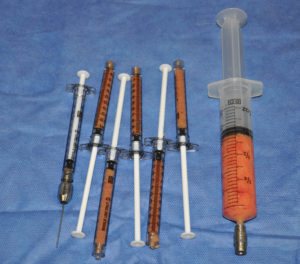The concept of injectable soft tissue fillers/augmentation has evolved dramatically over the past ten years. Besides the near continuous introduction of commercially-produced synthetic injectable fillers, using one’s own fat has also become mainstream. Although injectable fat grafting is far from perfect, it continues to become refined and more dependable.
Sometimes patients are understandably confused about the differences between these two injectable filler techniques. Because they both are injectable, it is not always easy for patients to see that they are not interchangeable and usually have very different indications for use. They differ in the areas of facial volume potential, technical complexity, treatment location, long-term rejuvenation effects, and cost.

As a general rule, injection of the lips and nasolabial folds is best done by the synthetic fillers. In areas like deep creases, folds, wrinkles, and lines, all areas with a lot of facial muscle motion around them, fat doesn’t work well. Injectable fat is best used to contour the face by adding to volume deficient areas. It is not a good fold or wrinkle reducer.
Synthetic injectable fillers are almost always done in the office, require no preparation and their placement techniques are relatively simple. Avoiding lumpiness and having a smooth and even injection site is the end goal. Conversely, fat injections need to be done in more of an operating room setting, require significant preparation, processing and time, and a more skilled injection technique. Even though fat grafting is considered by many physicians to be similar to working with fillers, these procedures are definitely more complex.
Every known synthetic injectable filler used has a limited lifespan. Whether it be a few months or up to a year or longer, they all will eventually go away. There is also no real evidence that they can stimulate some permanent volume by collagen stimulation. Fat, however, can have some permanency and can even overgrow with time, something a synthetic filler can never do. Whether it is the survival of the fat cells or through the benefit of the stem cells that are carried with it that causes the injected fat volume to persist is not currently known. While not all injected fat survives, it always as the potential because of its cellular component. Hence, the rejuvenation potential with fat injections.
Dr. Barry Eppley
Indianapolis, Indiana


